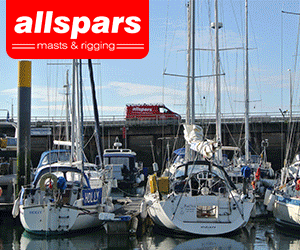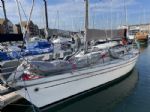












Boats for sale
| Rossiter Pintail Mortagne sur Gironde, near Bordeaux |
 |
| Laser 28 - Excellent example of this great design Hamble le rice |
 |
List classes of boat for sale |
Port/Stbd and tacking |
Post Reply 
|
| Author | ||||
jeffers 
Really should get out more 

Joined: 29 Mar 04 Location: United Kingdom Online Status: Offline Posts: 3048 |
 Post Options Post Options
 Quote Quote  Reply Reply
 Topic: Port/Stbd and tacking Topic: Port/Stbd and tackingPosted: 10 Apr 17 at 12:14pm |
|||
|
Situation that happened at the weekend.
2 boats (single handed dinghies sailing in F2) approaching on opposite tacks. P cannot cross S so elects to do a late duck and come immediately back up to close hauled. As P crosses the transom of S they change course to come back to close hauled. S also simultaneously tacks leaving both boats very close together. As S completes her tack there is light contact as P bears away to try and avoid a collision and S heads up to do the same. S did turns but there was discussion after. So what do people think? My interpretation was that S broke rule 13 (while tacking) and possibly rule 11 (overlapped, WW boat must keep clear). P was entitled to change course back to close hauled as they had kept clear of S by ducking and S tacking meant that rule 15 (acquiring right of way) applied between them the right of way for P was established by the action of S.
|
||||
|
Paul
---------------------- D-Zero GBR 74 |
||||
 |
||||
JimC 
Really should get out more 

Joined: 17 May 04 Location: United Kingdom Online Status: Offline Posts: 6661 |
 Post Options Post Options
 Quote Quote  Reply Reply
 Posted: 10 Apr 17 at 12:30pm Posted: 10 Apr 17 at 12:30pm |
|||
|
Agree. Reckon as soon as previous S passes head to wind she is give way boat (RRS13), and continues to be give way boat as Windward. Because L (previous P) acquires ROW as a result of S' action she is not required to give S room to keep clear. W, on the other hand is required to give L room as soon as she passed head to wind.
|
||||
 |
||||
Brass 
Really should get out more 
Joined: 24 Mar 08 Location: Australia Online Status: Offline Posts: 1151 |
 Post Options Post Options
 Quote Quote  Reply Reply
 Posted: 10 Apr 17 at 2:39pm Posted: 10 Apr 17 at 2:39pm |
|||
|
C'mon guys,
P acquires right of way because of S's actions [when S passes head to wind]. Rule 15 does NOT apply. From the time S passes head to wind, she is required to keep clear of P, initially rule 13 then rule 11. As long as P does not change course so as to fail to give S room to keep clear (rule 16), room does NOT apply. There is contact, seemingly after S had reached a close hauled course. S broke rule 11. There was no constraint on S dwelling in hear tack or otherwise avoiding contact with P. S broke rule 14. S was neither entitled to right of way nor room. S cannot be exonerated for breaking rule 14 under rule 14( b ). It would not have been clear to P that S would continue to rotate through her tack so as not to keep clear of P: it was not reasonably possible for P, acting no sooner than it was clear that S was not keeping clear, to avoid contact with S. P did not break rule 14.
Edited by Brass - 10 Apr 17 at 2:40pm |
||||
 |
||||
jeffers 
Really should get out more 

Joined: 29 Mar 04 Location: United Kingdom Online Status: Offline Posts: 3048 |
 Post Options Post Options
 Quote Quote  Reply Reply
 Posted: 10 Apr 17 at 3:20pm Posted: 10 Apr 17 at 3:20pm |
|||
I would have thought the second half of rule 15 was very relevant here 'unless she acquires right of way because of the other boats actions.' S was saying the P should have given them room to keep clear under 16.1 but she was not entitled to room to keep clear due to how the right of way was established. S also says that P came above close hauled which I am guessing they were not allowed to do so without giving room under 16.1 but were perfectly entitled to resume their previous (and proper) course?
Edited by jeffers - 10 Apr 17 at 3:22pm |
||||
|
Paul
---------------------- D-Zero GBR 74 |
||||
 |
||||
giraffe 
Posting king 
Joined: 10 May 07 Online Status: Offline Posts: 148 |
 Post Options Post Options
 Quote Quote  Reply Reply
 Posted: 10 Apr 17 at 3:51pm Posted: 10 Apr 17 at 3:51pm |
|||
|
As the boats converge P must keep clear of S
P does this by going behind S Once P has gone behind S they are moving apart from each other. Once S is tacking, S must keep clear of all boats Once S has completed its tack they may be windward boat relative to P, and still required to keep clear P does not need to anticipate what S might do next and P may alter course as she pleases S needs to make sure that she can keep clear Once P realises S is going to get too close she should try to avoid contact In these circumstances it really is practically impossible for P to foul S The situation will be exacerbated if S is headed as P goes behind. This is a problem for S and not for P. The solution is for S to delay its tack. |
||||
 |
||||
Brass 
Really should get out more 
Joined: 24 Mar 08 Location: Australia Online Status: Offline Posts: 1151 |
 Post Options Post Options
 Quote Quote  Reply Reply
 Posted: 10 Apr 17 at 11:32pm Posted: 10 Apr 17 at 11:32pm |
|||
P acquired right of way because of S's action in passing head to wind. Rule 15 did not apply.
S seems to be confusing rules 15 and 16. In your OP you say 'as P crosses the transom of S they change course to come back to close hauled.' Presumably (at least on P's evidence), P then held a steady close hauled course. At that time P changed course, it is highly unlikely that S had passed head to wind, thus P was still give way boat and under no obligation to give S room under rule 16.1. Even if S had passed head to wind when P changed course back to close hauled, S still had ample room to hold up in the tack and keep clear of P. Only if P made further changes in course after S began to bear away to close hauled is P exposed under rule 16.1, and given that S could always hold up or luff back, there is always room for S to keep clear. Maybe, just maybe, if P put in a quick luff (whacked up by a wave or whatever) just as S was reaching close hauled, it could be argued that P changed course too fast for S to respond. That's putting stuff in your OP that isn't there.
Proper course is irrelevant. Rule 17 does not apply because the overlap began when S passed head to wind and simultaneously became a port tack boat and required by rule 13 to keep clear (rule 17, last sentence). Whether P sails above close hauled or not is none of S's business unless, in order to do so, P changed course in such a way that that she did not give S room to keep clear. This sounds like S tried a slam dunk, when it wasn't on, and is now wriggling.
Edited by Brass - 10 Apr 17 at 11:39pm |
||||
 |
||||
Brass 
Really should get out more 
Joined: 24 Mar 08 Location: Australia Online Status: Offline Posts: 1151 |
 Post Options Post Options
 Quote Quote  Reply Reply
 Posted: 10 Apr 17 at 11:36pm Posted: 10 Apr 17 at 11:36pm |
|||
Edited by Brass - 10 Apr 17 at 11:37pm |
||||
 |
||||
Post Reply 
|
| Forum Jump | Forum Permissions  You cannot post new topics in this forum You cannot reply to topics in this forum You cannot delete your posts in this forum You cannot edit your posts in this forum You cannot create polls in this forum You cannot vote in polls in this forum |
Bulletin Board Software by Web Wiz Forums® version 9.665y
Copyright ©2001-2010 Web Wiz
Change your personal settings, or read our privacy policy
Copyright ©2001-2010 Web Wiz
Change your personal settings, or read our privacy policy











 Printable Version
Printable Version Delicious
Delicious Digg
Digg Facebook
Facebook Furl
Furl Google
Google MySpace
MySpace Newsvine
Newsvine reddit
reddit StumbleUpon
StumbleUpon Twitter
Twitter Windows Live
Windows Live Yahoo Bookmarks
Yahoo Bookmarks Topic Options
Topic Options